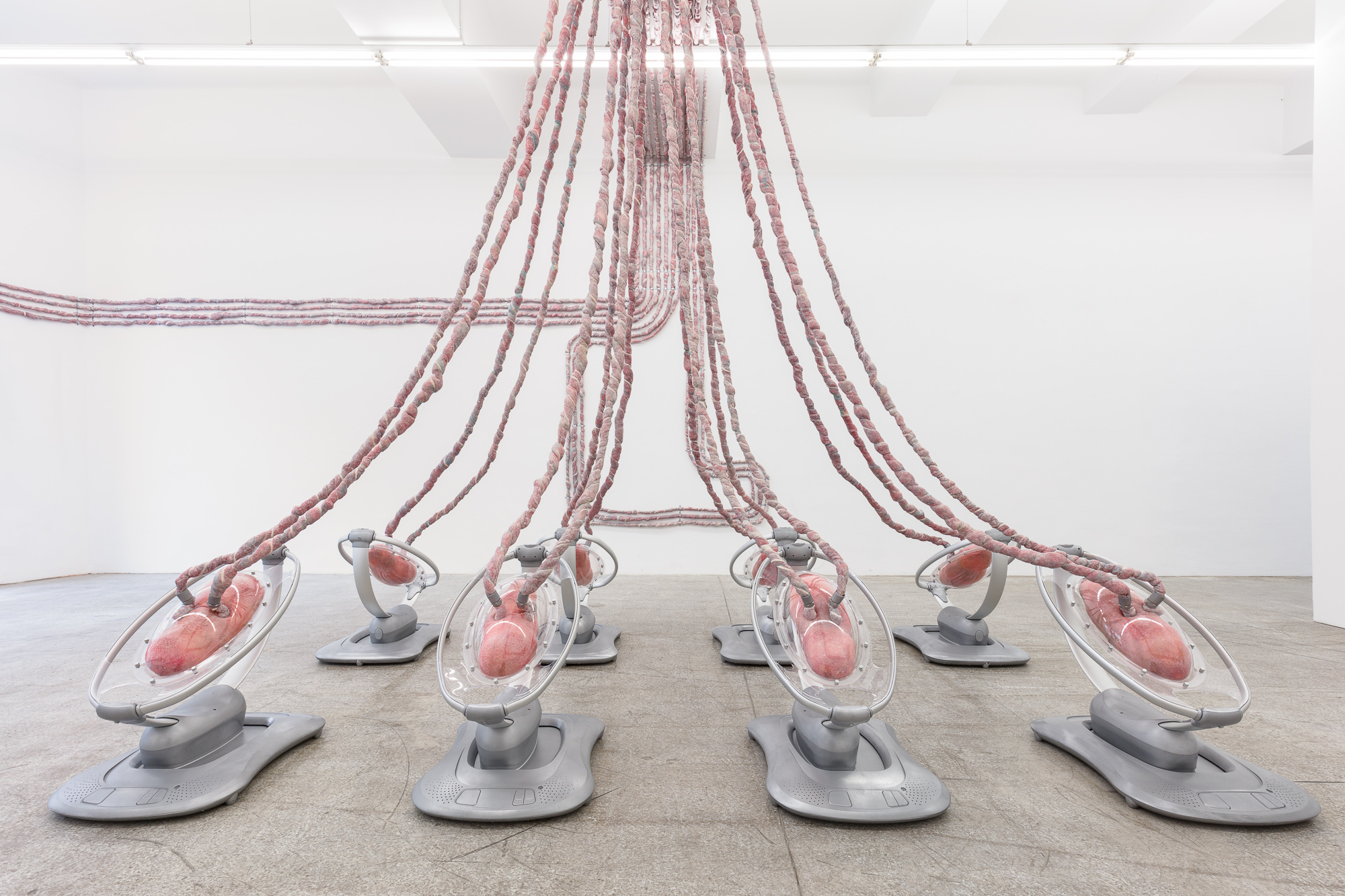Marie Munk & Stine Deja: Duo Show
Freitag, 09. Oktober 2020 - 11:00 Uhr
untitled Projects
Cable-to-Cradle presents an alternative reality that balances the imaginative with the peculiar and gruesome. For untitled projects, Munk has produced 8 coherent works that form a complete installation. The gallery space is filled with high-tech cradles, each carrying a sort of artificiahttps://www.untitled-projects.at/?post_type=exhibition&p=617&preview=truel uterus. The 8 meticulously aligned cradles in the bright gallery space are united in a comprehensive circuit of umbilical-like cords. The circuit manifests itself as extensively complex but systematically organized cable systems across the gallery's ceiling and walls, creating a bizarre mix of a delivery room and a data center.
The present is shrinking. If you look at the graphs of population growth, CO2 emissions, acidification of the oceans, loss of biodiversity, increase in computing power and so on, an exponential pattern emerges, where within the last few decades it draws a steep curve. Everything is changing more and more fast and it is increasingly difficult to keep up. Simultaneously technology is more and more often entering and replacing biological processes from which we humans for thousands of years have defined our existence.
With Cable-to-Cradle Marie Munk establishes a pause for thought by confronting visitors with the increasing fusion of body and technology in the very infancy of life; man's most fragile stage.
In the work Cable-to-Cradle Marie Munk explores the concept of ectogenesis; a technology where a child is created in an artificial uterus - a so-called ’biobag’.
In the course of time ectogenesis will, in all probability, make it possible to perform fertilization and pregnancy outside the physical framework of the body. The artificial wombs can act as high-tech foster mothers and make the bodily pregnancy an unnecessary risk. Perhaps one would even think that it is more ethical to use biobags, as it seems like an impossibility to dehumanize or exploit a machine.
The ectogenesis of the future interferes with the basic biological conditions of man and helps to bind the human body and technology even more closely together. Is it a natural part of human evolution in an anthropocene age where we are slowly freeing ourselves from the burdensome bonds of biology? Or do we risk stigmatizing the body's biological processes without knowing the actual consequences for our body and psyche? How will the notion of motherhood change as it becomes more and more entangled with technology?
’Cradle-to-Cradle’ is a term born of the Green Transformation and describes biological and technical circuits where consumption and production have a positive effect on the economy, the environment and people.
The exhibition title Cable-to-Cradle plays on this idea of a circular and positive system, and contains a belief in a bright future in relation to the synergy between people and technology. At the same time, the title breaks the cycle and refers to how we increasingly let technology interfere earlier and earlier in our human lives.
With an ‘uncanny’ visual language, Munk evokes the emotions that arise when we encounter something unknown and immediately abhorrent, in an attempt to speak to the unconscious and irrational in people. With Cable-to-Cradle she is hoping to open people's imaginations and challenge normative notions of the biological human being at a time when technological innovation, momentum and productivity both characterize and dominate our environment, our behavior and our bodies.
In the rear space there is the duo work by Munk und Stine Deja: Synthetic Seduction.
Through video and sculpture, Synthetic Seduction creates a playful and interactive space that examines the influence of technology on our intimate experiences.
With a common interest in how technology changes human social behavior, Deja and Munk explore the relevant question posed by the transhumanist thinker Mark O'Connell:
"Can a machine learn to be a human?"
Through a futuristic laboratory that simulates the familiar hospital room, Munk introduces interactive sculptures that simulate artificial forms of physical presence. Each one is seen together with video works by Deja. The videos create a playful contrast between algorithmic logic and romantic clichés. With the work the two artists invite deeper reflection on what love and intimacy are, and whether these can be replaced by surrogates produced by the unprecedented possibilities of the technology.
Stine Deja’s practice explores the sticky in-between of real and virtual worlds with a striking arsenal of media that includes 3D animation, immersive in- stallation, moving image, and digital surrogates. In Deja’s simulated spaces, uncanny avatars hinge between what’s strange and familiar, seducing us with not-quite-real products informed equally by the artist’s simultaneous fascination and revulsion with our hyper-commercialized contemporary culture. Concealed beneath a sleek surface, multiple layers of social critique meld with absurdist aesthetics
and tragicomic narratives to create a cybernetic landscape of fantasy and desire. At the heart of all of Deja’s projects is a keen interest in how these heightened emotional states, often coaxed out by late capitalist narratives of self-care and guilt-free indulgence, are displaced onto the body. Foreigner, a solo work by Deja, is a video installation featuring an android situated in a clinical robotics lab singing the 1984 pop classic 'I Want To Know What Love Is' to themself in a vanity mirror. The ‘foreigner’—an other— appears as a newborn learning to experience emotion.

